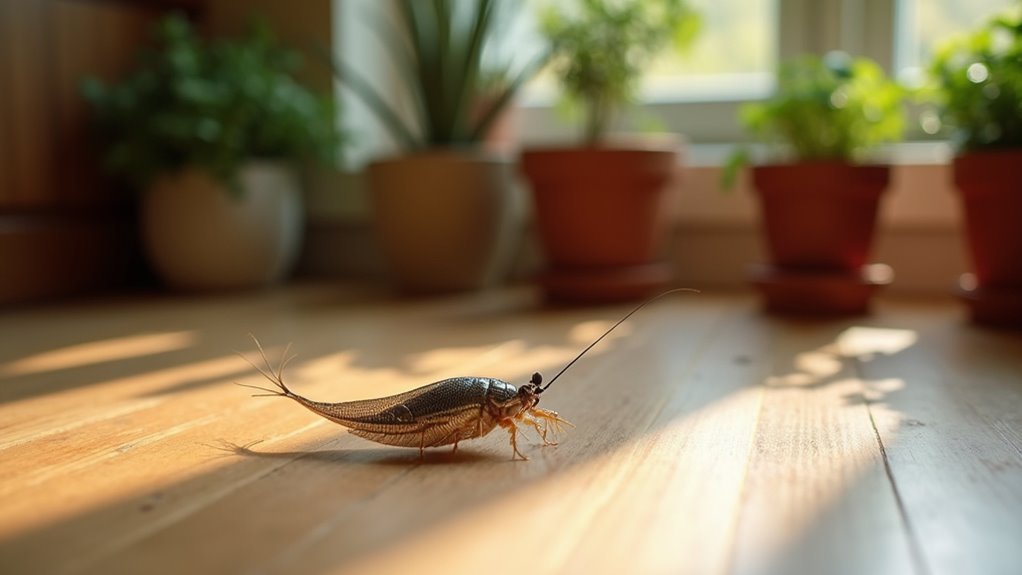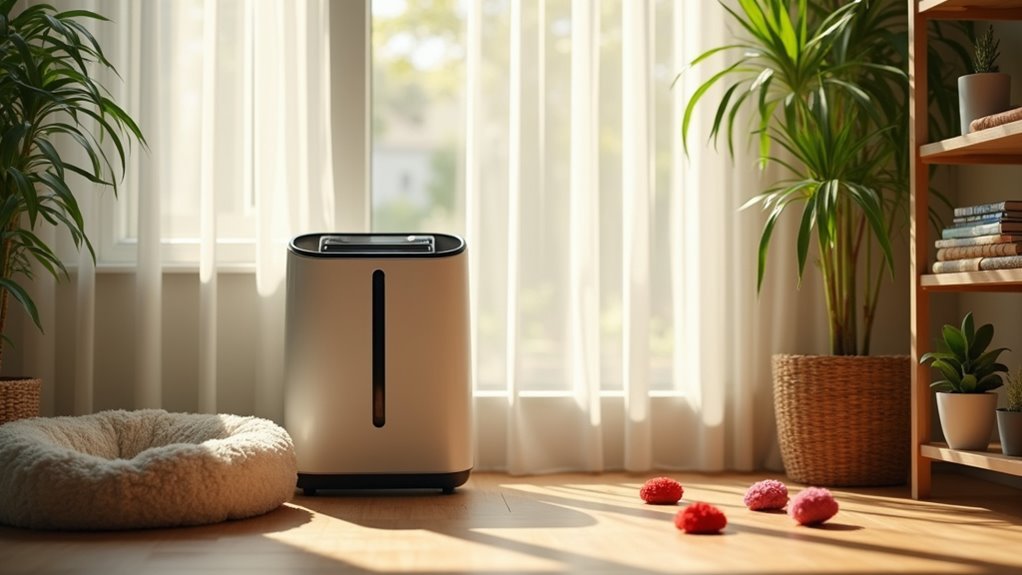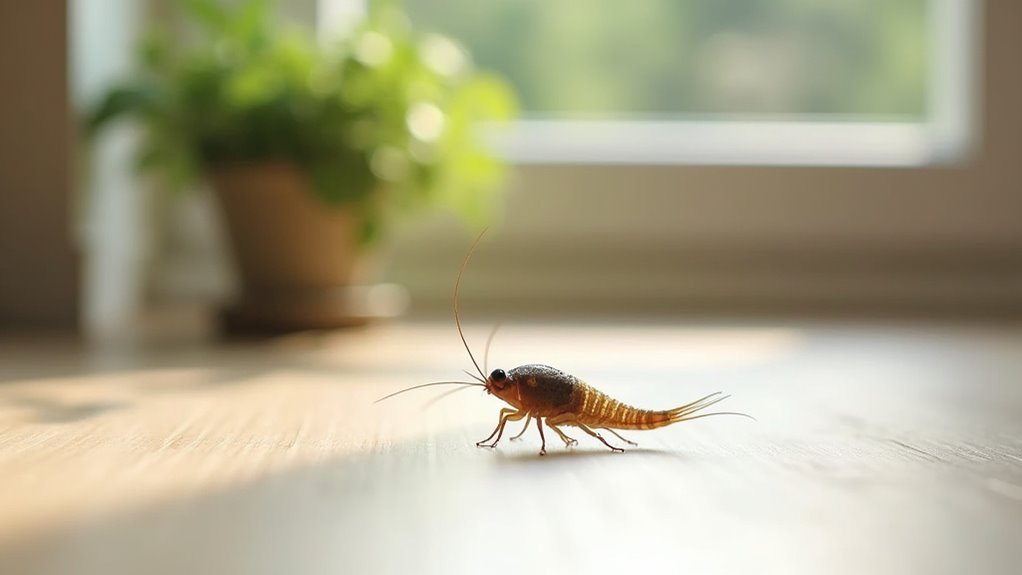You can eliminate silverfish safely by using natural repellents like cedar and peppermint essential oils, which won’t harm your pets. Create DIY traps with glass containers wrapped in tape, placing them in dark, humid areas where pets can’t reach them. Control moisture by maintaining humidity below 50% and storing pet food in airtight containers. Avoid traditional insecticides containing pyrethroids or organophosphates that pose risks to animals. These thorough strategies will help you discover effective long-term solutions.
Understanding Silverfish Behavior and Pet Safety Risks

When you’re dealing with silverfish in your home, understanding their nocturnal habits becomes essential for effective and pet-safe elimination. These pests prefer dark, humid environments like bathrooms and basements, making daytime detection challenging.
Since they’re active at night, you’ll need strategic approaches that won’t compromise pet safety.
While silverfish don’t bite or sting your pets, they create allergens through droppings and skin molts that can trigger sensitivities in vulnerable animals. This makes controlling any silverfish infestation particularly important for households with pets prone to allergies.
Traditional insecticides pose risks to your furry companions, so you’ll need safer alternatives.
To prevent silverfish effectively while protecting pets, focus on reducing humidity levels and using natural deterrents like mint or cedar essential oils instead of harsh chemicals.
Identifying Pet-Safe Silverfish Control Products
Since traditional pest control products often contain chemicals that threaten your pets’ well-being, you’ll need to carefully evaluate silverfish control options before bringing them into your home.
Look specifically for pet-safe products labeled as free from pyrethroids or organophosphates, which can harm your furry companions.
Natural repellents offer excellent alternatives for silverfish control. Essential oils like mint oil and cedar oil effectively deter silverfish without endangering pets.
You can also create simple traps using starchy foods in glass jars wrapped with tape—these capture silverfish safely without toxic substances.
Boric acid-based baits work well when placed in areas your pets can’t access.
Always follow manufacturer guidelines and maintain clean, dry environments with dehumidifiers and sealed food containers.
Natural Repellents That Won’t Harm Your Pets

Why risk your pet’s health with harsh chemicals when natural repellents can effectively keep silverfish at bay? Essential oils like cedar and peppermint work exceptionally well as natural repellents when used moderately around pets.
Simply diffuse these oils or apply diluted solutions to silverfish-prone areas.
Apply diluted essential oil solutions directly to baseboards, closets, and other areas where silverfish commonly hide and feed.
You can also place dried bay leaves in drawers and storage spaces – they’ll deter silverfish without threatening your furry friends.
Create a vinegar-water spray for areas where silverfish congregate; the strong scent repels them while remaining non-toxic to pets.
For silverfish traps, use cornstarch in glass jars to attract and capture these pests without harmful chemicals.
Don’t forget regular vacuuming and dusting – these simple habits remove eggs and food sources while maintaining a pet-safe environment.
Essential Oils for Silverfish Prevention Around Animals
You’ll find that certain essential oils can effectively repel silverfish while keeping your pets safe when used correctly.
Peppermint, lavender, and cedarwood oils offer proven results, with peppermint oil showing up to 80% effectiveness against these pests.
Proper dilution and strategic application to entry points guarantees you’re protecting your home without endangering your furry companions.
Pet-Safe Essential Oils
When you’re dealing with silverfish but have pets at home, essential oils offer a natural solution that protects both your family and furry friends. Pet-safe essential oils like peppermint, cedarwood, and lavender effectively repel silverfish without toxic chemicals.
| Essential Oil | Silverfish Repelling Properties | Pet Safety Benefits |
|---|---|---|
| Peppermint | Strong scent deters insects | Safe when diluted properly |
| Cedarwood | Natural insect repellent + antifungal | Gentle on most pets |
| Lavender | Calming scent that repels pests | Non-toxic to animals |
Always dilute these oils in water before application to reduce potency. Apply diluted solutions in areas where silverfish hide to create natural barriers. Remember to monitor pets’ reactions when introducing new scents, as some animals may show sensitivity even to safe essential oils.
Proper Application Methods
Three simple steps confirm you apply essential oils effectively while keeping your pets safe from both silverfish and potential oil reactions.
First, dilute 10-15 drops of peppermint, cedarwood, or lavender oil in water before spraying targeted areas like basements and kitchens where silverfish hide.
Second, remove your pets from treated spaces until the solution completely dries, preventing accidental ingestion or skin contact.
Third, conduct patch tests on surfaces before full application to avoid damage to household items.
You’ll need to reapply these safe for pets essential oils every few weeks, especially in humid environments where silverfish thrive. This regular maintenance creates an effective barrier against infestations.
Always consult your veterinarian about specific essential oils to confirm they’re completely safe for your particular pets.
Effectiveness and Precautions
Essential oils offer proven effectiveness against silverfish infestations, with peppermint, cedarwood, and eucalyptus showing particularly strong repellent properties that won’t harm your furry companions.
These pet-friendly solutions create natural barriers when you place cotton balls soaked in diluted oils around problem areas. You’ll maintain potent deterrent effects while protecting your pets’ sensitive respiratory systems through proper dilution with water.
However, you must monitor pets closely for any allergic reactions or sensitivities, since individual animals can respond differently to essential oils.
Watch for unusual behaviors, excessive sneezing, or skin irritation. Reapply treatments every few weeks to sustain effectiveness against silverfish.
This consistent approach guarantees your home remains pest-free while keeping your beloved animals safe from harmful chemical exposure.
DIY Trapping Methods Safe for Households With Pets
You can create effective silverfish traps using simple glass containers filled with starchy bait like oats or bread, wrapping the outside with tape to prevent escapees while keeping pets safe from harmful ingestion.
Sticky traps designed for crawling insects offer another reliable solution, but you’ll need to position them strategically out of your pets’ reach to avoid accidental contact.
These DIY methods let you target silverfish directly without introducing toxic chemicals into your home environment.
Glass Container Traps
Glass container traps offer one of the simplest and most pet-safe methods for capturing silverfish in your home.
You’ll need a clean glass jar and starchy bait like oats or sugar to attract these pests. Wrap the jar’s exterior with double-sided tape to prevent silverfish from escaping once they enter the trap.
Position these traps in dark, damp locations where silverfish typically hide—bathrooms, basements, and kitchens work best.
To guarantee pet safety, place the glass container traps out of your pet’s reach or use lids with small openings that allow silverfish entry while keeping curious pets out.
Check your traps regularly and dispose of captured silverfish promptly. Refresh the bait as needed to maintain effectiveness.
Sticky Trap Placement
Sticky traps provide another effective pet-safe option for controlling silverfish populations throughout your home.
You’ll want to place these traps in areas where silverfish commonly appear, such as under sinks, behind appliances, and in dark corners. Always position them out of your pets’ reach to prevent accidental contact.
Choose non-toxic sticky traps that don’t contain harmful chemicals, making them safer than many common household pest control products.
Enhance their effectiveness by using baited traps with starchy foods like oats or sugar, which attract silverfish naturally. Focus on high-humidity locations where these pests thrive, but guarantee traps remain inaccessible to curious animals.
Check and replace traps regularly to monitor activity levels. This approach often proves more economical than hiring pest control services.
Moisture Control Strategies in Pet-Friendly Homes

Since silverfish thrive in humid environments, controlling moisture becomes your primary defense against these pests while keeping your furry friends safe.
Moisture control is your best weapon against silverfish infestations without compromising your pets’ health and safety.
You’ll need to maintain indoor humidity below 50% using dehumidifiers or air conditioning to eliminate silverfish breeding conditions. Install exhaust fans in bathrooms and kitchens for proper ventilation without creating pet hazards.
Regularly inspect and repair plumbing leaks using pet-friendly sealants and materials. Store your pet’s food in airtight containers within dry, cool areas away from moisture sources. This prevents attracting silverfish while protecting your pet’s nutrition.
Clean and vacuum pet areas frequently to remove food particles and excess moisture levels.
Always use pet-friendly cleaning products to guarantee your animals’ safety throughout the process.
Sealing Entry Points Without Using Toxic Materials
While moisture control creates an unfavorable environment for silverfish, you’ll also need to physically block their access routes using safe materials that won’t harm your pets.
Start by identifying entry points around windows, doors, and foundation walls, then seal these cracks with non-toxic caulk. For larger gaps, install copper mesh—it’s completely safe yet effective at deterring silverfish without chemicals.
Cover all exterior vents with mesh screens to prevent access while maintaining proper ventilation.
Don’t forget to inspect plumbing and electrical conduits for gaps, repairing them with non-toxic materials.
Finally, organize storage areas and seal boxes with non-toxic adhesive tape to eliminate hiding spots.
These simple steps create an impenetrable barrier using only pet-safe, non-toxic materials.
Pet-Safe Cleaning Solutions for Silverfish Prevention
You can create effective silverfish deterrents using natural ingredients that won’t harm your pets.
Cedar oil and essential oils like mint provide powerful repelling properties when applied correctly around your home’s problem areas.
These safe alternatives let you maintain a silverfish-free environment while protecting your furry family members from toxic chemical exposure.
Natural Repellent Ingredients
Five natural ingredients can effectively repel silverfish while keeping your pets completely safe from harmful chemicals. These natural deterrents provide powerful protection without risking your furry family members’ health.
| Ingredient | Application Method | Pet Safety Level |
|---|---|---|
| Essential oils (mint, cedar, lavender) | Apply to cotton balls in problem areas | Completely safe for pets |
| Dried bay leaves | Place directly in silverfish-prone zones | No risk to animals |
| Diatomaceous earth | Sprinkle around infested areas | Safe for pets when food-grade |
You’ll find these solutions work exceptionally well against silverfish while maintaining a pet-friendly environment. The strong scents from essential oils and bay leaves naturally repel these pests, while diatomaceous earth eliminates them through dehydration without chemical toxicity.
Safe Application Methods
When applying pet-safe cleaning solutions for silverfish prevention, start by creating essential oil sprays that combine peppermint or cedar oil with water in a spray bottle.
These safe application methods target areas where silverfish hide without endangering your pets. Spray around baseboards, closets, and damp spaces regularly.
Set up homemade traps using glass containers filled with starchy bait like oatmeal.
Wrap the outside with tape so silverfish can climb in but can’t escape. Position these traps away from pet feeding areas.
When using pet-friendly insecticides containing boric acid, follow label instructions carefully for effective silverfish control.
Apply sparingly in areas your pets can’t access. Combine these treatments with regular vacuuming using HEPA filters to remove debris safely.
Storage Techniques to Protect Belongings and Pets
Protecting your belongings and pets from silverfish requires strategic storage methods that create barriers while maintaining a safe environment for your household. These storage techniques form an essential component of effective pest management while prioritizing your pets’ safety.
| Storage Method | Silverfish Prevention | Pet Safety Benefit |
|---|---|---|
| Airtight plastic/glass containers | Blocks access completely | Controls moisture and allergens |
| Vacuum-sealed bags | Deters pests effectively | Minimizes allergen exposure |
| Cedar chips/lavender sachets | Natural repellent properties | Non-toxic to animals |
| Regular cleaning/inspection | Eliminates habitats | Reduces pest-related health risks |
Avoid cardboard boxes since they absorb moisture and attract silverfish. Instead, choose sealed containers that prevent access while controlling humidity levels. Regular inspection and cleaning of storage areas eliminates potential habitats, protecting both belongings and pets from allergens.
Room-by-Room Pet-Safe Silverfish Elimination
Beyond storage solutions, you’ll need targeted approaches for each room where silverfish commonly appear.
In bathrooms, install dehumidifiers and improve ventilation to eliminate moisture while using mint essential oils around baseboards.
For kitchens, clean food spills immediately and place glass container traps with starchy bait near appliances.
In bedrooms, declutter magazines and books regularly while applying cedar oil to closet corners.
Basements require thorough moisture control through proper ventilation and strategic placement of pet-safe traps containing tape-wrapped starches.
Your pest control plan should address silverfish and other pests room-by-room using natural repellents that won’t harm pets.
Focus on removing hiding spots among household items and maintaining dry conditions.
Consult pest control professionals specializing in pet-friendly solutions for persistent infestations.
Monitoring and Maintaining a Pet-Safe Environment
Since effective silverfish control requires ongoing vigilance, you’ll need to establish a regular monitoring routine that keeps both pests and pets safe.
Inspect areas where your pets frequent weekly, looking for silverfish droppings or damage to household items to catch infestations early. Set up pet-safe traps using glass containers with starchy foods wrapped in tape to monitor activity without endangering your animals.
Control humidity levels below 50% using dehumidifiers and proper ventilation, as silverfish thrive in moist conditions.
Apply natural repellents like cedar oil that deter pests without harming pets. Schedule monthly cleaning and decluttering sessions to eliminate potential silverfish habitats while maintaining clean, safe spaces for your pets.
This consistent approach prevents infestations before they become serious problems.
When to Call Professional Pet-Friendly Pest Control Services
Despite your best monitoring efforts, some silverfish infestations prove too stubborn or widespread for DIY solutions alone.
When you’re dealing with persistent problems, it’s time to call professional pet-friendly pest control services that can eliminate silverfish safely.
Consider professional help when you notice:
- Visible infestation signs – droppings, yellow stains, or damaged household items
- Failed DIY attempts – your efforts haven’t reduced the silverfish population
- Pet distress – your animals show signs of stress from pest control measures
- Recurring problems – silverfish keep returning despite treatment
Professional pest control companies like NaturePest offer customized, non-toxic treatment plans using integrated pest management strategies.
Professional exterminators provide tailored, pet-safe solutions using comprehensive pest management approaches to eliminate stubborn silverfish infestations effectively.
They’ll identify moisture issues and entry points while ensuring your pets’ safety throughout the elimination process.
Frequently Asked Questions
How to Get Rid of Silverfish Without Harming Pets?
You can use cedar oil, dried bay leaves, or sticky traps in pet-inaccessible areas. Create starchy food traps in taped glass containers, apply pet-friendly boric acid carefully, and regularly clean to eliminate their food sources.
What Do Silverfish Hate the Most?
Silverfish hate strong scents most, especially peppermint, cedar, and lavender essential oils. They also despise dry environments, so you’ll find reducing humidity levels particularly effective at driving them away from your home.
What Can I Pour Down My Drain to Kill Silverfish?
You can pour baking soda and vinegar down drains to disrupt silverfish habitats. Essential oils like peppermint diluted in water also repel them. Regular hot water flushes eliminate eggs safely.
What Do Exterminators Use to Kill Silverfish?
Exterminators use borate-based insecticides and orthoboric acid bait granules to kill silverfish. They’ll also apply pet-friendly chemicals like bifenthrin sparingly, while recommending humidity control and sealing entry points for prevention.
In Summary
You’ve got effective tools to eliminate silverfish without compromising your pets’ safety. Stick to natural repellents, essential oils, and DIY traps while maintaining proper storage practices. Monitor your progress regularly and don’t hesitate to contact pet-friendly professionals when needed. By following these room-by-room strategies, you’ll create a silverfish-free environment that keeps your furry family members healthy. Consistency in your approach will guarantee long-term success in protecting both your home and pets.





Leave a Reply